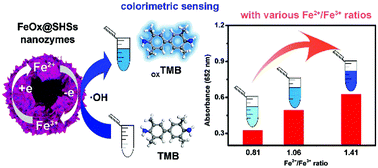Sensitive colorimetric glucose sensor by iron-based nanozymes with controllable Fe valence†
Abstract
The proportion of Fe2+ and Fe3+ in Fe-based nanozymes is a key point in determining their catalytic activity. However, it is hard to adjust the Fe2+/Fe3+ ratio in nanozyme systems to achieve the best catalytic performance. In this work, we successfully regulate Fe2+/Fe3+ ratios in a wide range of 0.81–1.45 based on a novel porous platform of Fe doped silica hollow spheres. The homogeneous distribution and stable fixation of Fe components in Fe doped silica hollow spheres facilitate the valence regulation of Fe in the reduction heating in H2/Ar. When the Fe doped spheres (FeOx@SHSs) were used as nanozymes, different Fe2+/Fe3+ ratios have shown to influence the peroxidase-like catalytic activity greatly. The highest activity at the ratio of 1.41 should be due to the combined effects of the accelerated reaction rate by Fe2+ and the enhanced catalytic cycle efficiency by Fe3+. The FeOx@SHSs-based nanozyme is further applied to construct a facile colorimetric biosensing system, which exhibited extremely sensitive determination of glucose. This work presents an effective platform for controlling Fe valences and optimizing the peroxidase-like activity for catalytic processes or sensing systems.



 Please wait while we load your content...
Please wait while we load your content...